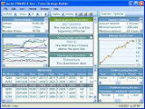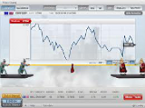Monetary policies
Central banks are responsible for creating, implementing and governing monetary policy in a country. While some of these mandates and goals are shared by the different central banks, there are goals that are unique. Ultimately, monetary policy boils down to promoting and maintaining price stability and economic growth.
The distinction between the various types of monetary policy lies primarily with the set of instruments and target variables that are used by the monetary authority to achieve their goals.
Goals
- Price Stability
- High Employment
- Economic Growth
- Interest Rate Stability
- Financial Market Stability
- Foreign Exchange Market Stability
| Monetary Policy | Target Market Variable | Long Term Objective |
|---|---|---|
| Inflation Targeting | Interest rate on overnight debt | A given rate of change in the CPI |
| Price Level Targeting | Interest rate on overnight debt | A specific CPI number |
| Monetary Aggregates | The growth in money supply | A given rate of change in the CPI |
| Fixed Exchange Rate | The spot price of the currency | The spot price of the currency |
| Gold Standard | The spot price of gold | Low inflation as measured by the gold price |
| Mixed Policy | Usually interest rates | Usually unemployment + CPI change |
Policy of various Nations
Australia - Inflation targeting
Brazil - Inflation targeting
Canada - Inflation targeting
Chile - Inflation targeting
China - Monetary targeting and targets a currency basket
Czech Republic - Inflation targeting
Colombia - Inflation targeting
Eurozone - Inflation targeting
Hong Kong - Currency board (fixed to US dollar)
India - Multiple indicator approach
New Zealand - Inflation targeting
Norway - Inflation targeting
Singapore - Exchange rate targeting
South Africa - Inflation targeting
Switzerland - Inflation targeting
Turkey - Inflation targeting
United Kingdom - Inflation targeting, secondary targets on "output and employment". In general the US attempts to maintain a steady inflation of between 2% to 3%.
United States - Mixed policy
- The role of central banks
- Monetary policies
- Interest rates 101
- Central banks you need to know

1. ABC of fundamental analysis
- What is fundamental analysis?
- Exchange rates and supply and demand
- Top 5 factors that affect exchange rate
- Political and economical performance
2. Central banks, Monitory policies & Interest rates
3. Fundamental indicators
- Macroeconomic indicators
- Inflation indicators
- Employment indicators
- How to use fundamental indicators
4. Using fundamental factors

Forex Educational Articles & News

There are many factors that affect exchange rates of currencies. However some are more important in currency trading than others. These are; Interest and Inflation rates, Trade balance, Currency market speculation, Foreign investment and Central bank market intervention. Learn how to use these factors in your forex tra ...




